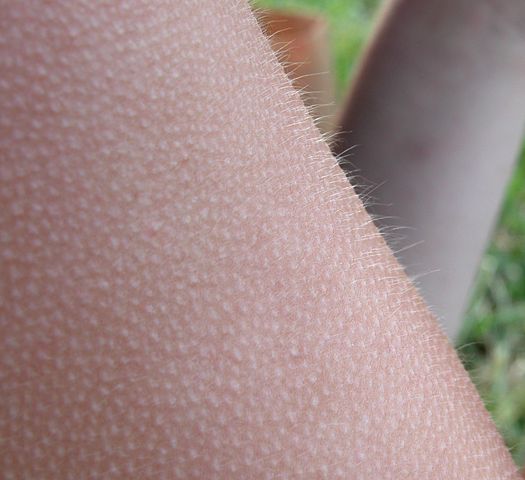
Why do we get goosebumps? Goosebumps are a reaction left over from when humans used to have a thick coat of fur.
I’m sure you have all experienced goosebumps at some time in your life. It is when bumps appear on your arm that resemble plucked goose skin. In fact, the medical term is cutis anserine, which means “skin goose”.
There are many things that can cause goosebumps, but it is usually down to temperature or strong emotion.
Whatever the stimulus, an electrical discharge from the brain goes down the nerves and causes the little muscles around each hair follicle to contract. These muscles are called arrectores pilorum (hair erector). When these muscles contract, the hair follicles stand up. We don’t have any hair in those follicles, but we do still have the follicles. The follicles bunch up and these are goosebumps.
So, why do we even get goosebumps in the first place? You have to go back about two million years for the answer to this. About two million years ago, humans had a thick coat of fur. When the weather was cold, the goosebump reaction would make the hair follicles stand up and would thicken the fur. This would allow more air to be trapped in the fur and it would insulate the human against the cold more effectively.
When humans were experiencing fear, anger, or other strong emotions, the goosebump reaction would make the hair follicles stand up, again thickening the fur. This would make the human look bigger in order to scare off predators or enemies. Goosebumps also serve another purpose. The stimulation of the muscles triggers the stem cells that are in the follicle to produce more hair. If the animal is living in cold conditions, the goosebump reaction triggers a lot and it encourages the stem cells to produce more hair to keep the animal warm.
The goosebump reaction we still have is a vestigial reflex, meaning that it is something we used to rely on but no longer need. About 15 to 25% of people don’t have the goosebump reaction. Because it is something that we no longer need, you would think that evolution would take it away. However, there is no evolutionary advantage to not having the goosebump reaction, so there is no reason why evolution would select against it. It is most likely here to stay.
All animals that have fur have a goosebump reaction. If you have a cat, watch it when it is scared. The goosebump reaction will make its hair stand up, thickening its fur and making it look bigger. This is exactly what we used to do.
A related question is why don’t we have fur anymore? Well, it turns out that nobody actually knows for definite. There are some good theories, though. One is that we lost the hair on our palms and wrists so that we could make and grip stone tools. Having hairless palms would have been an advantage and evolution would have selected for it. Another theory is that we lost our all over body fur so that we could cool ourselves down more effectively. When we lived in the forests and trees, there was no problem being covered in hair, but when we started to walk and moved out onto the savannah to hunt, we ran a serious risk of overheating. Losing the hair and developing more sweat glands, allowed us to thermoregulate. We also discovered fire and clothing, which meant we had no need for the warmth of fur.
There is another theory that is fascinating. Humans have three different cones in our eyes. The cones are the part of the eye that detect wavelengths of light and allow us to see color. Most animals only have two, but we have three, and the third one allows us to see lots of shades in the middle of the spectrum. The theory is that we lost the hair on our necks and faces so that we could see people’s color more easily. We could use facial color as signs of anger, embarrassment, or sexual attraction, or of illness. Studies in monkeys have found that those with hairless faces tend to have three cones in their eyes and those with hair faces, two.
So, we have goosebumps because our furry ancestors needed to make their fur thicker to insulate against the cold or to scare off potential dangers. And this is what I learned today.
Sources
https://www.nih.gov/news-events/nih-research-matters/what-goosebumps-are
https://www.livescience.com/32349-what-causes-goose-bumps.html
https://www.smithsonianmag.com/science-nature/why-did-humans-evolve-lose-fur-180970980/
https://www.discovermagazine.com/planet-earth/why-do-people-get-goosebumps
